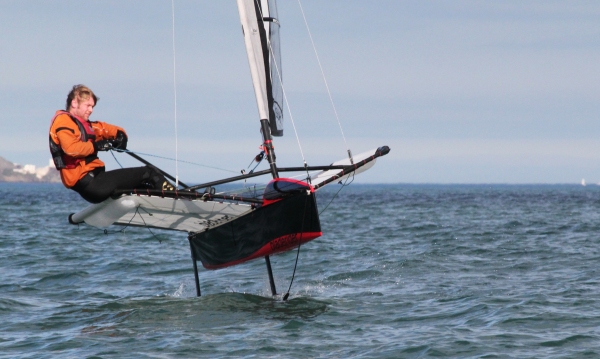Displaying items by tag: John Chambers
#moth – Five Irish sailors – including three Olympians – got a lesson in the complexities of International Moth sailing at the Hayling Island class world championships last week. In an event won convincingly by Australian Nathan Outteridge, the National Yacht Club's Rory Fitzpatrick was one of two Irish skippers to make the 70–boat gold fleet. Fitzpatrick finished mid fleet in 36th with London 2012 49er helmsman Ryan Seaton of Belfast lough in 45th.
Annalise Murphy was next best finisher taking 17th in the 63–boat silver fleett but significantly it was a result that also gave the Dubliner the woman's Moth world championship title. Alistair Kissane was 18th and the John Chambers steered new Irish built prototype 27th.
The forecast for the final day of racing was for no wind, but it turned out to be a sparkling day with the best breeze of the week. Four races were held in glorious Summer racing conditions, with 10-14 knot winds, leading to very tactical racing.
Gold fleet racing started at 9.30am.
There were a few white-caps on the waves at the start of the final race - fantastic conditions.
The final leg became really unstable with all the leaders dropping off their foils at times. In the end Outteridge knocked in 15 gybes in a band of breeze to win the race by a country mile.
Nathan said about the final race, "It had got a bit soft in that very last race and I actually fell off the foils at the top mark. Josh Mcknight and Chris Rashley gybed in a really good puff, and I managed to gybe, get foiling again and did about 15 gybes down in this one little puff, turned around half-way to see how I was going and no-one was foiling so it was a pretty nice way to finish, to have a really big lead."
On Australia retaining the #MothAshes Josh Mcknight said, "Well I mean that's really all we come to these events for - the Moth Ashes. It's a great trophy to have as it puts emphasis on a bit of team spirit among Australia and England... A-Mac's got a knack for pulling something out of the bag, whether it be new kit or just a stellar result.
Top five, Gold Fleet:
1. Nathan Outteridge, AUS, 23 points
2. Chris Rashley, GBR, 33
3. Josh Mcknight, AUS, 34
4. Scott Babbage, AUS, 51
5. Ben Paton, GBR, 60
Full results here
#irishmoth – In another first for Irish sailing, a Bray, County Wicklow design and build of one of the world's leading edge dinghy types will make its debut on Saturday at the BMW Frank Keane Royal St. George Yacht Club regatta on Dublin Bay. Pioneering International Moth Sailor John Chambers will compete in the new foiling hull, from the design board of Chris Allen, against a burgeoning 12–boat Irish fleet that has attracted a range of top Irish dinghy sailors to its ranks.
In recent years, the International Moth, a development class, has literally take flight with the advent of lifting hydrofoils on daggerboard and rudder, which lift the entire hull and skipper above the water surface, dramatically reducing drag and increasing speed. Now Ireland is set to play its role in future development.
'It's a displacement hull, so not designed to foil in anything under six knots', says Allen of the new craft, that took its maiden sail at the National Yacht Club on Wednesday.
Top speeds of Moths can be above 30 knots. Last month, a former American Fireball dinghy sailor became the fastest dinghy sailor in the world, clocking up a time 36.5 knots This high speed is reflected in the International Moth's RYA Portsmouth Yardstick of 600, the fastest of any sailing dinghy or multihull.
The key features of the Irish design is that when the breeze is above six knots it will reach its foiling speed more easily than some existing designs. According to Chris, the Irish hull is a progression of existing designs and the hope is that its 'lift speed' will be quicker so the boat 'flies' sooner.
The design also features a new look at foil control systems with a smoother and more direct automatic adjustment.
The new hull is also 'more boat shaped than boxed shape' says Chris, who claims it is is stiffer than rivals because it has more shape, more rocker and rounded in the sides.
Constructed entirely in carbon fibre and weighing under eight kilograms, the boat will compete at the 2014 World Championships at Hayling Island in the UK in a fortnight in a fleet of 140 boats.
Depending on its world championship performance, Chris hopes the new hull called 'Voodoo' will be the first of many international orders.
The cost of the boat is comparable to other production Moths at approximately €12,000, depending on choice of rig and equipment.
Moth Dinghy Debuts on Dublin Bay
Since our report on Ireland's debut at the Moth worlds in January it was inevitable that one of these high speed sailing dinghies would appear on Irish waters soon enough. Yesterday, John Chambers took his first tack of 2011 on Dublin Bay in a Moth he bought in France. Clearly the high speed foiling craft did not go unnoticed. It got an immediate thumbs up from the nearby DMYC frostbite fleet sailing their penultimate race.
The Bladerider Moth came blasting back from the Baily lighthouse, according to eyewitness accounts. It has hydrofoils on the dagger board and rudder which lift the boat out of the water when sufficient speed is achieved.
It is Chamber's intention to sail the innovative dinghy in this Summer's Dublin Bay Sailing Club (DBSC) summer season.
Video of the Dublin Bay sail plus a photo from Bob Hobby is below:

Moth sailing on Dublin bay. Photo: Bob Hobby
Moth sailing in Ireland on facebook HERE































































